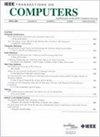DCAS-BMT:用于安全非易失性存储器性能增强的倾斜盆景默克尔树的动态构建和调整
IF 3.8
2区 计算机科学
Q2 COMPUTER SCIENCE, HARDWARE & ARCHITECTURE
引用次数: 0
摘要
传统的基于dram的内存解决方案面临挑战,包括高能耗和有限的可扩展性。NVM (Non-Volatile Memory)具有低能耗和高扩展性的特点。然而,安全挑战,特别是数据残留漏洞仍然存在。采用盆景默克尔树(BMT)等常用方法确保数据安全。然而,完整性树更新的一致性要求导致了性能问题。可以观察到,与没有持久安全元数据的安全NVM系统相比,使用持久安全元数据更新和持久化BMT根的平均开销高达2.48倍。因此,本文旨在通过利用内存访问局部性原则来减轻这些低效率。提出了倾斜盆景默克尔树(DCAS-BMT)的动态构建与调整。DCAS-BMT是动态构建的,并在运行时根据访问权值不断调整,确保频繁访问的内存块位于到根节点的较短路径上。这减少了频繁访问内存块的验证步骤,从而降低了内存验证和更新的总体成本。在USIMM存储器模拟器上的实验结果表明,与目前广泛使用的BMT方法相比,DCAS-BMT方案的性能提高了34.1%。本文章由计算机程序翻译,如有差异,请以英文原文为准。
DCAS-BMT: Dynamic Construction and Adjustment of Skewed Bonsai Merkle Tree for Performance Enhancement in Secure Non-Volatile Memory
Traditional DRAM-based memory solutions face challenges, including high energy consumption and limited scalability. Non-Volatile Memory (NVM) offers low energy consumption and high scalability. However, security challenges, particularly data remanence vulnerabilities, persist. Prevalent methods such as the Bonsai Merkle Tree (BMT) are employed to ensure data security. However, the consistency requirements for integrity tree updates have led to performance issues. It is observed that compared to a secure NVM system without persistent secure metadata, the average overhead for updating and persisting the BMT root with persistent secure metadata is as high as 2.48 times. Therefore, this paper aims to mitigate these inefficiencies by leveraging the principle of memory access locality. We propose the Dynamic Construction and Adjustment of Skewed Bonsai Merkle Tree (DCAS-BMT). The DCAS-BMT is dynamically built and continuously adjusted at runtime according to access weights, ensuring frequently accessed memory blocks reside on shorter paths to the root node. This reduces the verification steps for frequently accessed memory blocks, thereby lowering the overall cost of memory authentication and updates. Experimental results using the USIMM memory simulator demonstrate that compared to the widely used BMT approach, the DCAS-BMT scheme shows a performance improvement of 34.1%.
求助全文
通过发布文献求助,成功后即可免费获取论文全文。
去求助
来源期刊

IEEE Transactions on Computers
工程技术-工程:电子与电气
CiteScore
6.60
自引率
5.40%
发文量
199
审稿时长
6.0 months
期刊介绍:
The IEEE Transactions on Computers is a monthly publication with a wide distribution to researchers, developers, technical managers, and educators in the computer field. It publishes papers on research in areas of current interest to the readers. These areas include, but are not limited to, the following: a) computer organizations and architectures; b) operating systems, software systems, and communication protocols; c) real-time systems and embedded systems; d) digital devices, computer components, and interconnection networks; e) specification, design, prototyping, and testing methods and tools; f) performance, fault tolerance, reliability, security, and testability; g) case studies and experimental and theoretical evaluations; and h) new and important applications and trends.
 求助内容:
求助内容: 应助结果提醒方式:
应助结果提醒方式:


